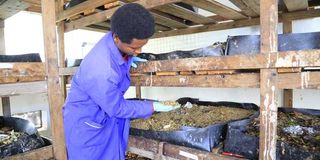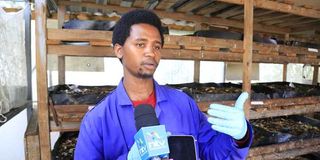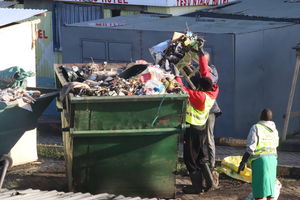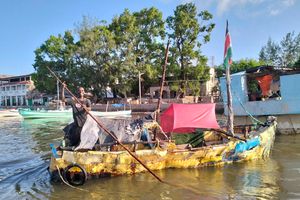
Mr Paul Ndungu, 30, explaining how the larvae is converted to animal feed on April 9, 2025.
In the heart of the world-renowned Maasai Mara, where tourists seek the magic of the wildebeest migration and breath-taking sunsets, an unlikely transformation is taking place at the JW Marriott.
Hidden behind the scenes of luxury hospitality is a sustainability initiative that is not only cleaning up the environment, but also curbing carbon emissions and restoring lost beauty to one of Kenya's most treasured landscapes.
The lodge’s Sustainability Hub, headed by Paul Ndungu, 30, is nurturing a black soldier fly farming project that recycles food waste into high-protein animal feed. Through a black soldier fly farming project, more than two tonnes of organic waste from the hotel are processed inside a larvarium designed to meet precise temperature and humidity requirements.
“We receive about 100-150kg organic waste per day, liquor bottles weighing 50-100kg per week and carbon papers weighing 50-60kg per week. If it weren’t for this project, the smell alone would be unbearable within the lodge, ,” says Ndungu.

Mr Paul Ndungu, 30, explaining to Nation team how the dried larvae are used as animal feeds at Maasai Mara, April 9, 2025.
With a Bachelor of Science degree from Kenyatta University and a nursing degree from Baylor University in Texas, US, Ndung’u walked away from a career in clinical work to practice environmental conservation.
“I saw firsthand in 2017 how climate change had begun to affect our wildlife. Diminished rains slowed migration, and tourists began to dwindle,” he recalls. “That experience pushed me to return home to Talek and start something that would help revive this environment and sustain local livelihoods,” he added.
Inside the larvarium, a custom-built, temperature-controlled greenhouse, black soldier flies are nurtured with scientific precision. The insects lay eggs, which hatch into maggots that feed on decomposing food waste to become larvae.
In just 10 days, these larvae grow rapidly, breaking down organic matter while producing rich protein sources. To successfully obtain these larvae, Mr Ndung’u explained that there are five stages that help the process succeed. The first step is allowing the flies to lay eggs, which are then kept for several days until they hatch into small larvae that are placed in the waste.
“These insects have a very short lifespan of 10 days then they die, so, to ensure the process continues, we make sure they lay eggs, some of which we allow to become adult flies, while others are used to consume the waste,” explains Ndung’u.
Each waste batch is carefully tracked with labeled timelines to ensure precision in the incubation and harvesting process. This data-driven approach ensures that the delicate ecosystem of black soldier fly larvae thrives and remains productive.

Mr Paul Ndungu, 30, explaining how the larvae is converted to animal feed on April 9, 2025.
The project is very crucial, therefore, Ndungu has to work with precise data to get the correct product out of it. This involves a sort of labelling, a very important step. He goes on to explain that they chose the black soldier fly instead of other ways to eliminate waste because they have a very low production of carbon emissions and methane gases.
“The black soldier fly larvae, once hatched under controlled greenhouse conditions, feed exclusively on organic waste. They are incredibly efficient but also delicate, a small mistake, such as feeding them highly fermented food, can wipe out an entire batch.”
After 14 days of growth, the larvae are sun-dried for three days and then transported to Nairobi and Kakamega for processing. Each kilogram fetches between Sh100 and Sh120, with harvests reaching up to 200 kilograms every two weeks.
After drying, the larvae is processed into high-protein animal feeds. “In just six months, the project has helped plant 300 trees and prevented the release of an estimated 18 tonnes of carbon emissions into the atmosphere, equivalent to 18 carbon credits.”
But it’s not just food waste that gets a second life here. Post-segregation, non-organic waste like carbon papers, discarded tissue and packaging material is transformed into smokeless charcoal briquettes.
“These briquettes burn for up to five hours without releasing carbon or smoke. They’re not only efficient, but also reduce our reliance on firewood,” he explains.
Looking around the room where once-rotting garbage now sprouts new life in the form of clean energy, animal feed, and green hope, Ndungu says he is not just managing the waste, but building the future.






